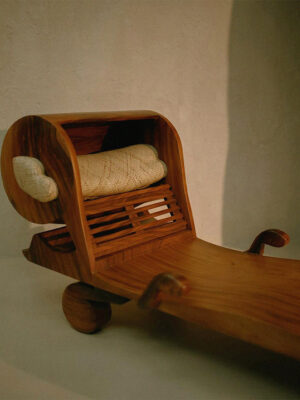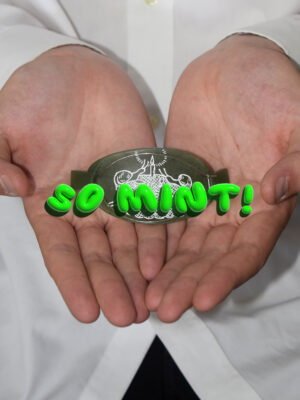It’s weird, but not any weirder than our previous stop that morning, the headquarters of the Church of Scientology. It was our last day in Los Angeles and we just couldn’t resist the denim blue, hangar-sized mother church, so a guy named Cory gave us a short tour and a crash course in Dianetics, a set of ideas with the goal of removing one’s ‘reactive mind’ from the metaphysical relationship between mind and body. And why not? It was only a short drive from where we had been staying all week nestled at the base of the Hollywood Hills, and short drives in LA are hard to come by. Not only was my sister Allyson my photographer for the week, she was also there to drive. It’s the only way to get around and traffic is always bad.
Welcome to Los Angeles.
___STEADY_PAYWALL___

Congested highways, bogus spirituality or affirmations at breakfast not your cup of tea? Don’t worry; LA isn’t always that superficial, you just have to know where to look. Somewhere between the billboards of Sunset Strip, the testosterone at Muscle Beach and the palm trees of Beverly Hills, we found five amazing artists and designers breathing air of their own. And finding them turned out to be nothing short of an electrifying scavenger hunt punctuated with vast doses of openness, nature and its own mystic creativity I have yet to find in other places. LA isn’t what you might think.
Four days prior, the first full day of our adventure began with a fifteen-minute drive east of Hollywood to the home studio of Elena Stonaker. We found ourselves gently tucked within the greenery of the Franklin Hills perched high above the city. We were greeted with big hugs, and the atmosphere was peaceful but alive. Elena’s own creations beautifully adorn the green and airy space, feeling like some kind of sophisticated tree house. Living intertwined with creating has almost entirely dissolved her separation of work and play.
Born and raised in Colorado, Elena grew up really connected to nature. Her parents farmers, her mother practicing energy medicine too. She left home when she was eighteen to New York City but was back and forth for some years while she discovered her voice. When things eventually clicked, she began to obsessively make dolls and struggled to sell them at craft fairs. ‘I liked hand making these things, they’re precious, they made very few people very happy… I just got really caught up in it and eventually it became more of an art practice rather than a craft practice’.
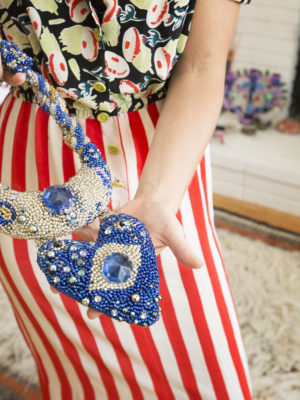
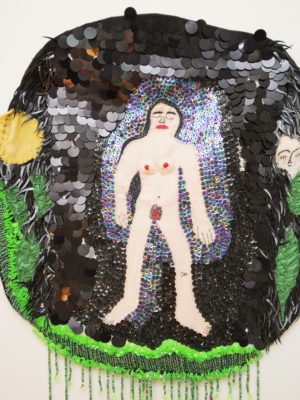
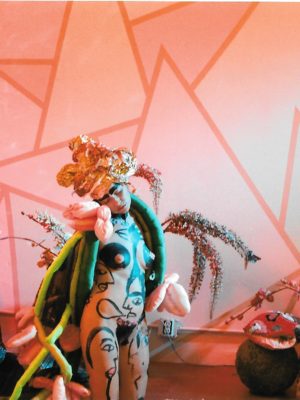
Her process is very organic. It’s about letting go and not having expectations. ‘I might start with an idea, or with a shape or animal, but it generally ends up growing. It’s a seed for whatever is bigger’. And what her work often ends up being is some kind of fantastical hybrid of tapestry and adornment; a bead embellished soft sculpture; or a hand embroidered three-dimensional drawing.
She also describes her process as destructive. While living in New York, this tendency helped Elena realize that her seemingly separate interest in garments could actually be one and the same with her art:
I had this 8-foot tall sculpture that I worked on for eight months, it was just covered with embroidery. I brought it to New York and it was too big for my space, and one day I lost it and I cut off the head of this big bird, and unstuffed it, I just ripped everything apart. But then I realized – oh, it’s supposed to be a jacket and a hat now. That’s kind of when I realized I wanted to use my work on the body, and have my sculptures be able to come to life.
The pull for her is the ceremonial aspect of adornment, its potential to be emotional armour – deflecting the negative, harnessing the positive – and its role in disguise and transformation, ‘into a totally different person, being, animal, spirit, whatever. People wearing masks, people wearing crowns, it’s the potential of how you’re perceived, how you feel in your own body, you put something on and all of a sudden you feel empowered’.
It’s about the way that something you put on can give you power. Symbols play a large role in this too, symbols as a shared language and means to connect with people, and unite ways of thinking. ‘They cross. There is no border of who you are, they are so loaded, and some of them come to me and I can’t stop drawing them’, whether they are moons, eyes, snakes… Elena says they are built into us. In high school, mythologist Joseph Campbell was a big influence, how he spoke of modern myth in society, archetypal symbols and patterns one can follow as humans. They drive us, and ‘will keep us in this beautiful alignment with the natural world and law’.
Creating pieces of jewellery has also been a part of Elena’s symbol sharing, albeit by accident. Once, while making various shapes with sewn together beads, she suddenly realized the shapes really wanted to be necklaces. ‘I think they have as much their own mind as I do, in a way, I’m just sort of the vessel.
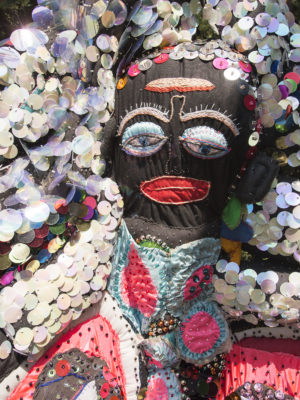
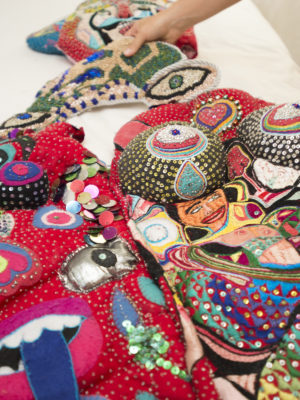
The way Elena describes her work in practise with others is transformation through positive manifestation, which can also be said about the way it’s created. It’s mostly about being mindful:
I think less about what I want to make and more about the message I want to make. The message that I want to send out into the world is that you can have any of your wildest dreams, anything your heart really wants; if you imagine it you can create it. So by making these objects then, I feel like I’m creating a vehicle for that mentality in the world. They are power objects, made with the intent to spread power to people.
A more recent goal for Elena has been to develop the levels of interaction she and her audience can access through her work. By organising experimental figure drawing workshops entitled Artist as Muse, she creates opportunities for the audience to add their own narratives through participation. Elena designs sets and costumes for these events and often paints figures directly on the model (friend and personal muse, Sarah Buckley) and on herself. Together they merge into one body during these three hour sessions that have taken place in her home and out in nature. These evenings are really performances, and a way for Elena to find self-empowerment and build a greater connection between her physical and metaphysical realities. She says that she’s always felt a bit awkward as a physical person, like her soul floats outside somewhere above. During the sessions she says she sees what it could be like to really enjoy being a physical body, the intimate interactive tableaus help her become part of her own.
During our visit, the mood is very jovial. At one point, I tried on a necklace of intricately woven bead-encrusted snakes. ‘That looks great on you. Are you feeling that power’? she asked, always smiling. She passed my sister a slick beaded baseball hat. ‘It’s all about keeping it real, it’s not like we’re always chanting to our crystals, we also go roller skating with rappers; it’s a delicate balance’. It sounds like a joke but Elena was referring to her evening plans; roller disco night with Snoop Dogg… actually. Later on her patio: ‘That’s the one where you sit in its lap and it makes all your dreams come true’. Referring to the soaring, sequined, long-limbed creature I had my eyes on since we arrived, I sat in its lap. It’s soft, I’m happy.
The main goal Elena has for her work is to really make strong connections; she feels too much in life has been pulled apart and put into boxes. Translating physical softness to emotional softness is often a means to accomplish this; ‘I just want to impart a lot of sweetness in people… I’m really on this soapbox about self-love which is coming from a place where I’m just really trying to love myself’.
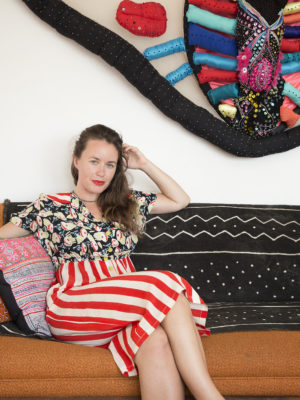
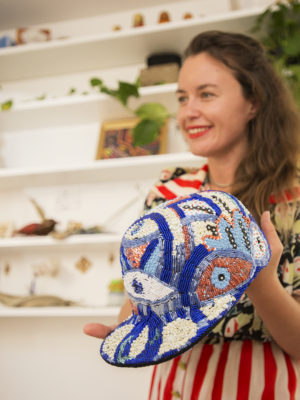
Feeling the love,
our LA scavenger hunt continued. Going westward, we took Mulholland Drive winding through the Santa Monica mountains, a view of the San Fernando Valley to one side and the distant downtown skyline to the other. We were headed to Bel Air. After a forty-five minute drive amid the small canyons that make up this residential area, we finally found the beautiful Cliff May ranch-style home of Lisa Eisner.
I first saw Eisner’s work on a New York Times video-feature a few years ago and was impressed by this woman’s sheer will to wear, her boldness in style – not only as the fashion icon she is considered, but as a designer of jewellery. It’s a relatively new pursuit for the photographer, publisher and former fashion magazine editor.
Lisa came to the door in a lime-green, vintage looking frock. With smooth, saxophone-heavy jazz in the background, we sat in her design-magazine living room. The resurrected colour palette of burnt oranges and gold, taxidermy animals, and minimalist art made me wish I had worn a pair of palazzo trousers. It’s 1970s chic but totally current. Something tells me that Lisa has an affinity for collecting; the wide array of amethyst geodes on the floor is one of many clues.
Long before Lisa started designing her own line, she’d been collecting jewellery, namely Native American pieces (in her home state of Wyoming) and jewellery made by fine artists, like Alexander Calder. Los Angeles is known for its remarkable flea markets, which are where she began to find the rare jewels that now make up her large collection. One of a kind American studio jewellery from the 1940s and 1950s is Lisa’s true jewellery love and a big source of inspiration for her own designs.
I mentioned Art Smith who was working in the Village in New York City in the 1940s. ‘Art Smith, oh my god, are you kidding’? she said enthusiastically. He is one of her favourites. Pal Kepenyes too, from Mexico. ‘When I found their stuff I was just – what is this? You didn’t care what it was made of. You can feel the hand… I want something where you can feel the work’. This is exactly how she feels about her own work, too.
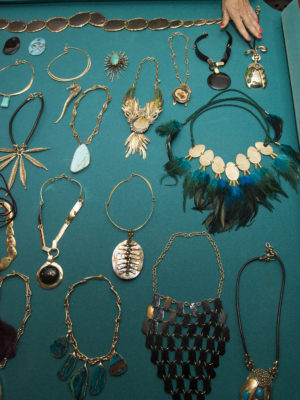
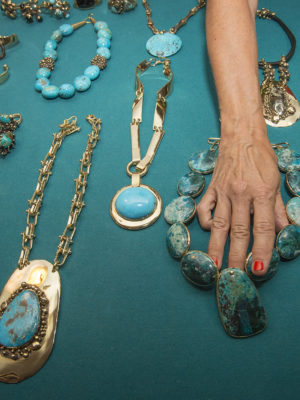
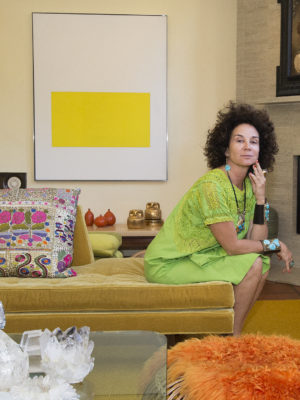
Metal, stone and ‘texture, texture, texture’ are the main ingredients for Lisa’s work. More specifically, it’s high-polished bronze with American turquoise, black jade, and black opal. She treats the bronze like it’s gold and, harking back yet again to American studio jewellery from the 1940s – 1970s, has no qualms that it isn’t. ‘Bronze is a beautiful metal, it’s not copper, it’s not brass… ‘ Lisa feels she would feel limited by gold’s cost and restricted to make much smaller work. On the other hand, ‘…bronze is like hey! You can go big and afford to make mistakes. So I love that freedom because first of all it’s very LA and it’s very ‘70s … it just looks gold and so it’s like this bling-bling and you can wear it big’.
As for the stones, they are very specific too. She sources them all herself from old miners and setters:
I wanted American turquoise. It’s one of those things you say – One day I’m going to know everything about Persian rugs, opera and turquoise. So I got to know it… I’m really a fanatic about where it comes from. It’s always American; it can’t be anything else. Even though I think Tibetan turquoise is really beautiful, I’m like, no, I can’t go there.
In the billiard room she had her jewellery sprawled out like candy on the pool table. It’s a sea of metal and stone, and feathers – another item Lisa collects. She’s recently incorporated feathers into her work via collaboration with a woman who does the hand dyeing. Collaboration has always been a vital component throughout Lisa’s entire career, especially now. She isn’t the one behind the bench. ‘I’m not a person who could just sit in a studio and just do that. I’m not that personality… so I found some people’. The first was an artist in San Diego, the second in New York that hand-forges and works with lost wax casting. ‘And I’ve gone to a lot of casters where it was like oh no no no. If I had to work with them, I’d never do jeweller., It was the opposite of fun, just awful. She attributes the success of her line to finding the right artisans to work with, and in turn, helping to fund their respective individual practices.
And speaking of the right collaboration, Lisa has most recently done a black feather-heavy line for friend, Tom Ford. Whatever her work ends up being, there’s a simple philosophy behind it:
‘How many things can you wear at one time? Well for me anyway. That’s what I do. And you can afford having more than one piece. They are all interchanging, somehow they always interlock. You know it’s like everything works with more’.
Whether it’s stone-encrusted bugs or beetles, a kelp bed textured cuff, even a marijuana leaf choker, Lisa’s designs reflect her appreciation for nature. Her backyard garden lays even further emphasizes. Palm trees, cactus and other succulents make up an extremely lush paradise; crystal gardens, beaded shrines and lounge areas pepper the extensive green maze that is protected by the long house. I asked her about her relationship to nature, she said it was spiritual – her soul, her balance, it’s everything. Supernatural?
Oh god yes, I love that word. We live in Oooga Booga World, so you know I depend on that. California is all about that, that’s another reason I really like living here because there are like-minded people who are really inspired by nature and live in nature… magic happens and you sort of take the time, listen a little bit more, you slow down a little bit, yeah I mean nothing would ever surprise me in life. Except maybe Jesus Christ coming down.
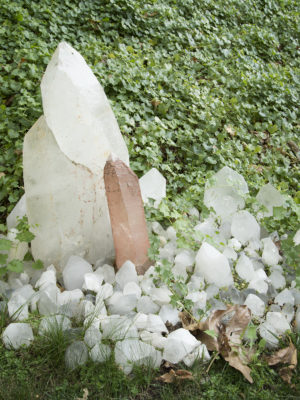
On the Venice Boardwalk, fish tacos, dudes on skateboards, new-age hippies and the ocean breeze made for a relaxed ending to day one. On day two, we were downtown bound, but not before a pit stop on Sunset Blvd. Whether you’re looking for crystals, herbs, tarot, a mystic – or even a Shamanic Maya Alter making class with a real Curandera – The House of Intuition is the place to go. Allyson and I just opted for some smoky quartz and hit the road.
Farther south and in the thick of the city, we whizzed down South Grand Avenue, passing the Walt Disney Concert Hall designed by Frank Gehry and its sparkling new neighbour, The Broad, a $140 million contemporary art museum designed by Diller Scofidio + Renfro. We ate a French dip sandwich among many 90+ year-olds at the legendary Philippe The Original, followed by a peak at some Mexican crafts down Olvera Street – the oldest part of Los Angeles from its Spanish owned days. Back in the car, we continued southeast to the Arts District, where ex-factories and 20th century brick warehouses make up this up-and-coming creative hub. Here we found our next studio visit with jewellery designer, Gia Bahm.
Though originally from Seattle, Gia started her jewellery label, Unearthen, in 2007 in New York City; you might recognize her claim to fame, the crystal bullet necklace. Though copied again and again, Gia made the original. Crystals have always been the centrepiece to her designs. Her business grew from her obsession with them, which started with visits to Manhattan’s Astro Gallery of Gems. Gia saw an opportunity to reinvent the idea of crystal jewellery into something fresh, fashion forward and as a way to do good for herself and for others. ‘Just having it be this new way for me to look at them, in more of an astrological way, as a talisman that you would have with you and have it remind you of something and have it less about… patchouli’.
In the beginning, she and her partners came up with different names for the crystals she had chosen to work with and wrote their meanings based around a lot of research. People started making appointments with her to sit down and explain the kinds of problems they were having, and ask what types of crystals could help to alleviate them. ‘I’ll get random texts from friends and people just being like, my friend’s mom is sick with this or that, what’s helpful’? Today it is still part of Unearthen’s mission to incorporate a form of education along with selling the jewellery. Just check out their website; there’s a stone guide that lists the general properties and health benefits of almost thirty different minerals, all of which are featured in various pieces of jewellery.
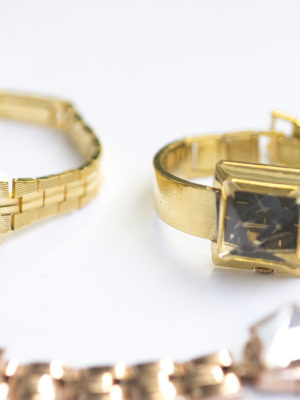
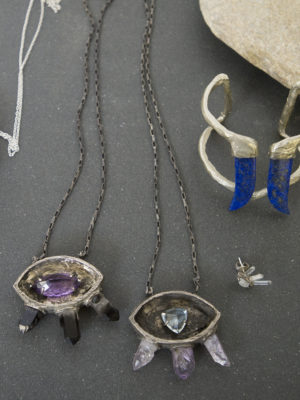
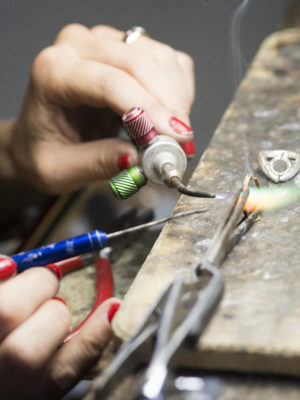
Unearthen’s space – which is rightfully littered with crystals and gems, bangles and bobs – is super chill. While Rachel, one of Gia’s three female team members soldered at her bench, Bob Dylan covering Simon and Garfunkel’s The Boxer played on the stereo while we looked around. The atmosphere was laid back though production is always in progress. Everything is made in house, piece-by-piece, and production is determined by demand. Gia’s design process is largely experimental through wax, hardly through sketching. Designs tend to start with a cast and then the team will slowly go from there.
The combination of stone and metal empowers all of Gia’s pieces whether they are brass chokers and cuffs with clear, round orbs; eye-shaped compositions for pendants and studs; long hanging, perfume carrying pendulums; or large pyramid quartz set atop gold timepieces.
I think it’s something about the combination of creation and destruction in me, I think it’s a really interesting idea and a lot of our pieces have a nice juxtaposition or function, there’s a function to it; how the watches –– time is really stressful, so to put something soothing on top of the time face for when you look at it – for a second you can look at it and think, wow that looks pretty.
Gia and her crew are constantly trying new things and thinking about what’s next – like small, freestanding talismans to hold chunks of burning Palo Santo, a cleansing method – or even rough-cut engagement rings. Despite the end result, it’s the process that always grips her the most:
I think about how you arrive at those things you like or think look interesting to you or beautiful, or it causes you to think okay, I think I got there. It’s such a trippy process, I don’t know how it’s possible. Whatever it is that I make, I’ll look at it weeks later and think I don’t even know how I got there. It’s like you are almost under a spell. It’s about getting into that meditative place where its just happening, it’s why I love making things so much, I think it’s why I do it.


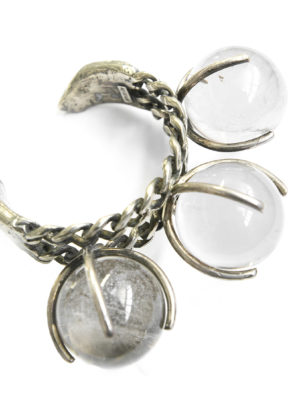
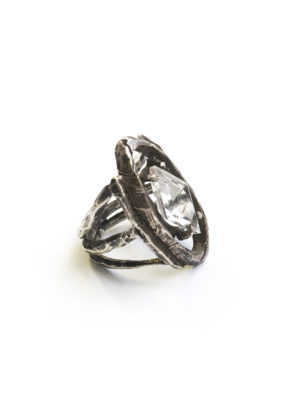

A confetti-filled street party in China Town ended our crystal-filled day, and the third opened under another kind of spell only made possible by LA’s mystical, ever tightening grip. We started with a visit to the Museum of Jurassic Technology in Culver City, one of the strangest, most fantastical, ‘institutions of the muses’ I’ve ever been to. A replica of Athanasius Kircher’s (16th century polymath) Magnetic Oracle; astronomical aurorae engravings by Etienne Leopold Trouvelot; a portrait of Laika the dog – the first earth born creature to go into space: these were only some of the curiosities on display that only added to the city’s magnetism.
Back on the road I started to understand why it was so easy for the three girls to have landed here, and the horizon of Pacific Coast further persuaded. We were then en route to our last visit of the trip. Santa Monica is where Highway 1 starts its scenic stretch of endless ocean running slightly north then west through Malibu. But just a few miles beforehand, with a sharp turn north into the rocky landscape lays Topanga Canyon – an old-school musician magnet/bohemian enclave nestled between conservancy lands, state park and the blue, blue ocean. This is the home of Carly Jo Morgan, her husband Matthew and their daughter, Cookie.
Since we had only found out about Carly – a California native – two days before as a tip from Elena, our excursion was rather spontaneous, not unlike Carly’s start with jewellery. It began a few years ago as a hobby that ran parallel to her practise as a painter of dream-like, symbol-filled psychedelic scenes. And it was neither her intention to start a business with it, but the right model on the right day of New York Fashion Week instagrammed a photo of one of her jewels. Subsequently, her line All for the Mountain really started to take off.
Making moulds of bismuth crystals then casting them to create ancient yet sci-fi looking pieces reminiscent of Incan palaces was the first series, Sacred Mountain. The Armageddon/Mother Ship collection followed in 2012 coinciding with the end of the world Mayan prophecy. ‘It was this idea of a new tribe that would come next and it was the women… this tribal woman coming forward. Crystal meteors, UFOs and breast shapes characterized the jewellery. ‘At the time we were living in Woodstock, so it was slightly cynical even though we’re totally into healing and crystals and yoga and sound baths. But everyone up there was a healer and a hustler at the same time’.
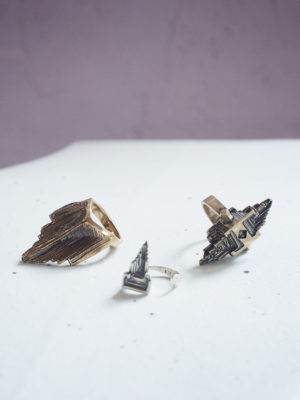
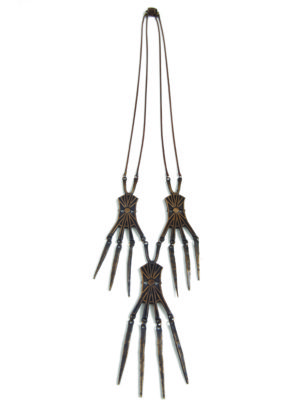
What Carly’s work has always seemed to maintain is that it’s part of a bigger narrative, an invented story in which one can participate and can have a piece of. More recently though the narrative she works through is very much her own, and her husband’s. Together they’ve been building a practise that blends their individual talents into one creatively fruitful union, through furniture. Since the two met, they’ve always been collaborating. Matthew likens it to having the exact same taste and aesthetic; ‘…sometimes we just don’t trust ourselves so we ask each other and then we always get the answer we need. It’s great, it’s a really nice creative partnership’.
Matthew has always had a knack for making three-dimensional work. And after ten years of experience building full-scale pieces for sculptors in New York, furniture came naturally to him. Being in California is
what started to open him up:
‘I was stuck in this high art verses low art mind set… and then after a year or two out here it was all of a sudden like, oh it would be cool to make furniture for our house. It wasn’t about the big questions; it was just about, what’s a cool chair? What’s a chair I’ve never seen? That Professor Xavier would sit in?
Professor Xavier from X-men, that is, but from the 1980s. That was the inspiration. He’s speaking about the slick, triangular power bench in their rustic, open-spaced living room that faces a work in progress rock garden outside. Matthew reminds us all that creating work of any kind can be that simple; it doesn’t have to fill in some conceptual cliff-hanger if it doesn’t want to. This might be why Carly and Matthew struggle with describing the overall visual language of their work together, which is actually quite refreshing. When talking about certain pieces, Matthew threw around some different influences that pop up: 70’s Italian, Crespi; neo-Egyptian; quasi post-modern revival; American Craft. I think it all looks like it’s from the future, as if someone rediscovered what wood was.

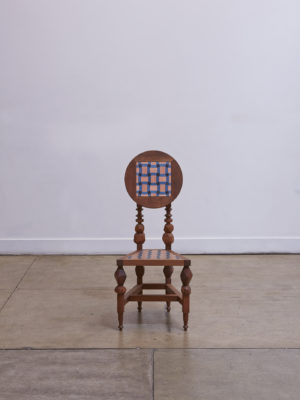

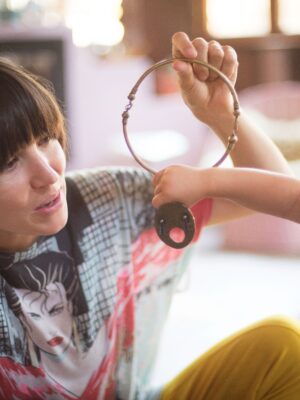
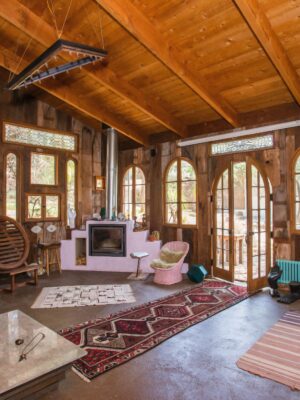
For Carly and Matthew, their home is a sanctuary. It’s tucked away in the country, it feels like the middle of nowhere. But although it’s rather secluded, their sense of community is anything but. For example, they started the Mercado Sagrado, an annual fair that showcases their favourite artists and artisans that, more recently has included a lecture series and curated sound stages. Since its first rendition (that they hosted at their home in Topanga), it has tripled in size. According to Carly:
Our goal is to create community and promote conscious commerce that supports hand-made and high crafted goods rather than planned obsolescence. In coming together, we are all inspiring and educating one another through art, music, nourishing food and healing modalities.
And love! They both say that’s all there is. It’s why they named their furniture business, Only Love is Real. The aspiration of their pieces is to help others create their own sacred space, ‘a place where they can feel like they’re in the presence of the supernatural or the presence of something transcendent… it’s about connecting’.
It’s safe to say that connection has been a fundamental element for all five of our artists and designers. To a certain extent, it also seems to be in large part of having found (or found again, like Carly) Los Angeles. In their own way, things just seemed to have quickly clicked after arrival. Elena came spontaneously via a solo Mustang road trip and said it was amazing from the moment she arrived. And Gia, not knowing she would stay, sublet her New York apartment but within two weeks had a studio, bought a car and had a new boyfriend. Perhaps it’s the balance of the overwhelming nature that can’t help but be inserted into the every day that makes things come together so well. The excellent weather doesn’t hurt. Matthew said it simply: ‘I think California has this cool thing where there is a lot of ambition, a lot of people working really hard, but then they are also going to the beach in the morning and surfing’. It’s that tension, an equilibrium, that kind of attitude spilling out everywhere. Or perhaps it’s that Oooga Booga thing Lisa talked about. Yeah, perhaps it’s that.
This article was first published in #4 Supernatural Issue of Current Obsession Magazine, 2015. You can order the issue here
